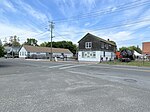Riverhead, New York

Riverhead is a town in Suffolk County, New York, United States, on the north shore of Long Island. Since 1727, Riverhead has been the county seat of Suffolk County, though most county offices are in Hauppauge. As of the 2020 census, the population was 35,902. The town rests on the mouth of the Peconic River, from which it derives its name. The smaller hamlet of Riverhead lies within it, and is the town's principal economic center. The town is 166 miles (267 km) southwest of Boston via the Orient Point-New London Ferry, and is 76 miles (123 km) northeast of New York City. In the beginning of the 20th century, the town saw an influx of Polish immigrants. This led to the creation of Polish Town, a section of the Town and County seat where the popular Polish Town Fair is held annually.Riverhead is the agricultural apex of Long Island, with 20,000 of the 35,000 acres of the island's farmland located within the town. The town is also home to four separate beaches which are open year round. Iron Pier, Wading River, and Reeves Beach each offer boating access for residents and visitors alike.
Excerpt from the Wikipedia article Riverhead, New York (License: CC BY-SA 3.0, Authors, Images).Riverhead, New York
Ved Stranden, Aalborg
Geographical coordinates (GPS) Address Nearby Places Show on map
Geographical coordinates (GPS)
| Latitude | Longitude |
|---|---|
| N 40.928333333333 ° | E -72.662222222222 ° |
Address
Ved Stranden
Ved Stranden
9000 Aalborg
Jutland du Nord, Danemark
Open on Google Maps








